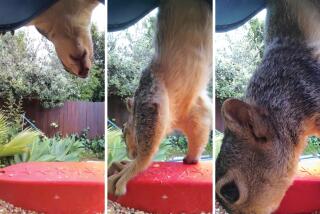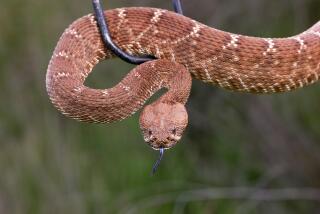Florida fights stucco-eating African snails
An epic battle is raging in South Florida: man against snail.
The state is struggling to contain an invasion of the giant African land snail, a species that thrives in hot and wet tropical climates. These gooey and destructive mollusks grow up to 8.5 inches long, feast on 500 different types of plants and nibble on calcium-rich stucco, which they use to construct their cone-shaped shells.
The snails are originally from East Africa but can now be found throughout the world. Aside from destroying plants and buildings, they can also be carriers of a type of meningitis.
Trevor Smith, an entomologist, is leading the eradication effort for Florida’s Department of Agriculture and Consumer Services. He spoke with The Times about the slimy invaders.
How big is Florida’s giant African snail problem?
Right now, luckily, we think we have it contained in 20 separate locations in the Miami-Dade County area. We know which properties are positive and which ones are not. At some of the locations we have collected 20,000 to 30,000 snails, while at other locations we may only find 10 or 15 snails. In total, we’ve collected over 118,000 snails at this point.
Are you finding the snails in residential areas or in open spaces?
It’s almost all residential areas. There are a few larger properties that might be 3 or 4 acres, but it is still mostly the typical urban Miami neighborhood — small plots of land with houses built in the ‘50s or ‘60s.
Do you know how the snails arrived in the first place?
We don’t know for sure. One possibility is the pet trade. The giant African land snail can live up to nine years in captivity, so people like to have them as pets. It could have been brought in for religious purposes — there are religious groups that use them. Also, there are some skin cream products that are popular in South America that use the slime of the snail, so it could be that. Or it could be multiple introductions. We just don’t know.
How long have they been there?
This is guesswork, but we think they have been here two to three years, based on the numbers, the size and the age.
Why do you want to get rid of them so badly?
The biggest issue is that there is hardly a plant out there they won’t eat. They like vegetables, fruit and landscape plants, and if you get enough of them, they can do quite a bit of damage. The second is they have to have calcium in their shell, and they are perfectly happy to climb on a wall and eat stucco. They can strip a house of stucco. Also, they can carry a parasitic nematode that can cause meningitis in humans.
And on top of all that, most people just think they are gross. They climb all over your wall, they defecate all over the place, and there is slime everywhere.
They multiply very fast, right?
Yes. You can get a sexually mature adult in as little as five months after birth, which can then go out and produce several thousand eggs a year.
Plus, they are hermaphrodites, so when you have two snails come together to breed, you have two pregnant animals that come away from that mating. That is really an amazing adaptation.
What else makes them such successful invaders?
They are very good at adapting to new environments because they eat so many types of plants, and because of their ability to estivate. We just went through a dry season, and they really need moisture, but all they do is create a thin film over the aperture of their shell, and they go into a hibernative state, and they can stay like that for months.
Also, they are capable of very low-level learning. For instance, if they eat a poison and it doesn’t kill them, they won’t eat it again. That is extremely important to treating these things. You have to have something that is strong enough to take them out the first time.
When did the eradication effort begin?
The program started in September of 2011. After our big giant African land snail symposium in April, we decided to use some new snail baits with metaldehyde that are stronger than the bait with iron phosphate that we were using before. Now our crews are finding many more dead snails than alive ones when they go out.
Isn’t metaldehyde toxic to mammals too?
It does have some toxicity to mammals, but there is a bittering agent added to the bait. If a child or a dog ate a little bit of it, they would instantly spit it out.
Does the South Florida public know it is under attack from giant snails?
As far as square miles go, the invasion is not a huge area, but our outreach has been extensive — it’s on billboards, on the sides of buses, in movie theaters and on the radio. We want to make sure that everyone is aware of this. It is definitely on people’s minds down there, no doubt about it.
Invasive species are a major problem in Florida. How big of a priority is this war on the giant African land snails?
This snail is on our top four or five list of species that we were looking for. We knew it was coming, and when it hit, we were ready to go.
Right now we have 50 people working on the program full time, including our field crews who are hand-collecting the snails and treating the properties with insecticide every two weeks.
Is this snail invasion different from other invasions you’ve worked on?
It’s a little bit comparable to the fruit fly eradication — the outreach and the techniques are similar, and the ultimate goal is to completely wipe it out. But as far as the organism goes, I’ve never dealt with an organism quite like it. There is a lot of variation in these snails’ behavior and that is what makes them so good at invading new areas — someone in the group can adapt to the new situation.
This interview was edited for clarity.







